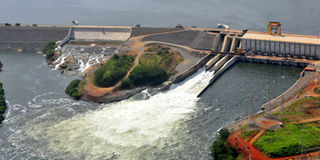Plugging Uganda’s energy shortfall

A section of Bujagali Hydropower Dam. Even with the addition of 250 MW, there is a likelihood that power cuts might resume soon. FILE PHOTO.
What you need to know:
Major point of concern. Even as the government claims that available electricity supply outweighs demand, there are concerns from experts and the business community that power cuts might soon resume.
It has been months of respite since the country last experienced major power cuts that had a crippling effect on the economy.
However, reports indicate the ‘honey moon’ is likely to be rudely interrupted as power cuts might resume soon.
These reports are attributed to the increasing unmet demand and the switching off of two thermal plants, whose combined generation capacity is 100MW.
But according to the Ministry Energy, such reports are ‘unfounded and misleading’ because Uganda has enough electricity with a number of back-up plans to cover deficiencies.
Speaking to Prosper, Mr Simon D’ujang, the state minister for Energy says the government has already put in place strategic interventions to forestall electricity shortages for the next five years.
Within the next five years, Mr D’ujanga notes a ‘comprehensive’ plan has been instituted to commence electricity generation from the vast gas reserves estimated at 12 billion standard cubic feet (339 million cubic meters).
He says, initially close to 50 (MW) could be generated and added onto the grid, which might also save the country from the costly thermal power generators.
Following government’s decision to scrap power subsidies; which shot up tariffs, the Electricity Regularity Authority (ERA) switched off two thermal plants, that had been generating close to 100 MW.
However, Mr D’ujanga maintains “the government continues to foot between Shs40 and Shs70 per unit,” which as he says justifies the fact that the subsidies were not wholly scrapped.
“We have adequate power in stock, but cuts might come in a years time due to technical failures including water shortages,” he says.
Raising concerns
The minister’s statements come at a time when the business community and investors at large continue to experience intermittent power supplies, even as the government claims that available electricity supply outweighs demand.
Even with the commissioning of power dams including Bujagali (250 MW) and Buseruka (9MW) among others, many parts of Uganda are still engulfed in absolute darkness.
About 72 per cent of total electricity supplied is consumed by about 12 per cent of the domestic population particularly in urban and peri-urban areas.
Only 12 per cent of Ugandans have access to electricity. This has only increased by about 2 per cent since 2006.
Similarly Mr Kenneth Otim, the spokesperson for Uganda Electricity Transmission Company Limited (UETCL), which buys and sells electricity in bulk, argues that the possibility of power cuts are far fetched.
He says presently electricity demand at peak is projected at 490 MW, according to the Ministry of Energy, and 470MW by UEDCL which does not call for alarm.
“When combined, Uganda generates about 504.2 MW from hydro and mini-hydro stations, out of which only 470 is consumed.”
Mr Otim says, if there is any power scarcity at the moment then Umeme should be held responsible for the shortfall.
“I can not rule out any future power cuts but it will not be substantial because we have done enough forecasts,” he says.
However, he adds any slight increase in power intake at the moment would be manageable with a supply excess of 34 MW.
“Thus he says ‘any power cuts , particularly due to a decrease in water flow at main dams, will be addressed through a request to the Directorate of Water Resources (DwD) to grant an increment in water flow.”
Recently water flow at the Owen Falls Dam was increased from 800 cubic metres per second to 1,000 cubic metres per second.
Since the commissioning of the 250 MW Bujagali Dam in October, demand for electricity at peak hours has increased from 450 MW to 470 MW.
However, generation capacity has since then only increased around stations not linked to the national grid.
This implies, there is relative power to drive the economy up to a certain level given the annual growth consumption of only 5 MW.
Eng D’Ujanga continues to be optimistic with the expected launch of the Karuma Hydropower project with a generation capacity of 600 MW. However, the commissioning of the project is two years behind schedule with numerous allegations of bribery.
Other projects include Ayago mini hydro project whose feasibility studies was completed by the Energy ministry, is yet to take off.
However, UETCL attributes the current power woes to service providers like Umeme; which operates an outdated system, whose rehabilitation is taking too long to be completed and the failure of other agencies including Rural Electrification Agency (REA) to meet its core mandate of extending power to rural areas .




